Introduction
Navigating the landscape of solar energy zoning presents a multifaceted challenge that requires a comprehensive understanding of various regulatory frameworks. As the push for renewable energy intensifies, stakeholders must familiarize themselves with the intricate web of local, state, and federal regulations that govern solar installations.
This article delves into the essential components of solar energy zoning, including:
- The necessary permits
- Common challenges faced during compliance
- Effective strategies for engaging with the community
By examining the critical steps to achieve and maintain zoning compliance, the discussion underscores the importance of proactive planning and community involvement in fostering successful solar energy initiatives.
Understanding Solar Energy Zoning: Key Regulations and Permits
Navigating solar energy zoning compliance requires a thorough understanding of local, state, and federal regulations. Among the key regulations are land use zoning laws that ensure solar energy zoning compliance by defining the permissible locations for renewable energy installations, along with environmental regulations that protect local ecosystems. It is vital to secure the appropriate permits before proceeding with any renewable energy project.
Commonly required permits include:
- Building Permits: Essential for the physical installation of photovoltaic panels, ensuring that structures comply with safety standards.
- Electrical Permits: Necessary for the safe connection of photovoltaic systems to the electrical grid, adhering to established electrical codes.
- Conditional Use Permits: These may be necessary if the proposed development does not conform to existing zoning laws, allowing for exceptions under specified conditions.
- Environmental Impact Assessments: In specific regions, these evaluations are required to assess the possible ecological effects of the photovoltaic installation.
In Kansas, for example, properties used for producing renewable electricity receive a 10-year property tax exemption after construction, which encourages landowners to engage in renewable projects. This considerable financial motivation prompts more landowners to explore renewable power options. Furthermore, Rhode Island's current use taxation program permits farmland designated for renewable resources to avoid land use change taxes, promoting financial viability for landowners.
Furthermore, it is crucial to highlight that the CA Pub Util Code § 2854 (2019) requires local publicly owned electric utilities to implement initiative programs related to renewable resources, further promoting the advancement of solar-related projects. It is crucial to research local zoning ordinances and consult relevant regulatory bodies to ensure solar energy zoning compliance with all requirements, thereby facilitating a smoother approval process for your energy initiatives. As emphasized by Wisconsin state law, any local regulations of wind systems cannot 'be more restrictive than the rules established by the (Public Service) Commission,' which highlights the significance of comprehending the wider regulatory framework that also affects energy zoning.
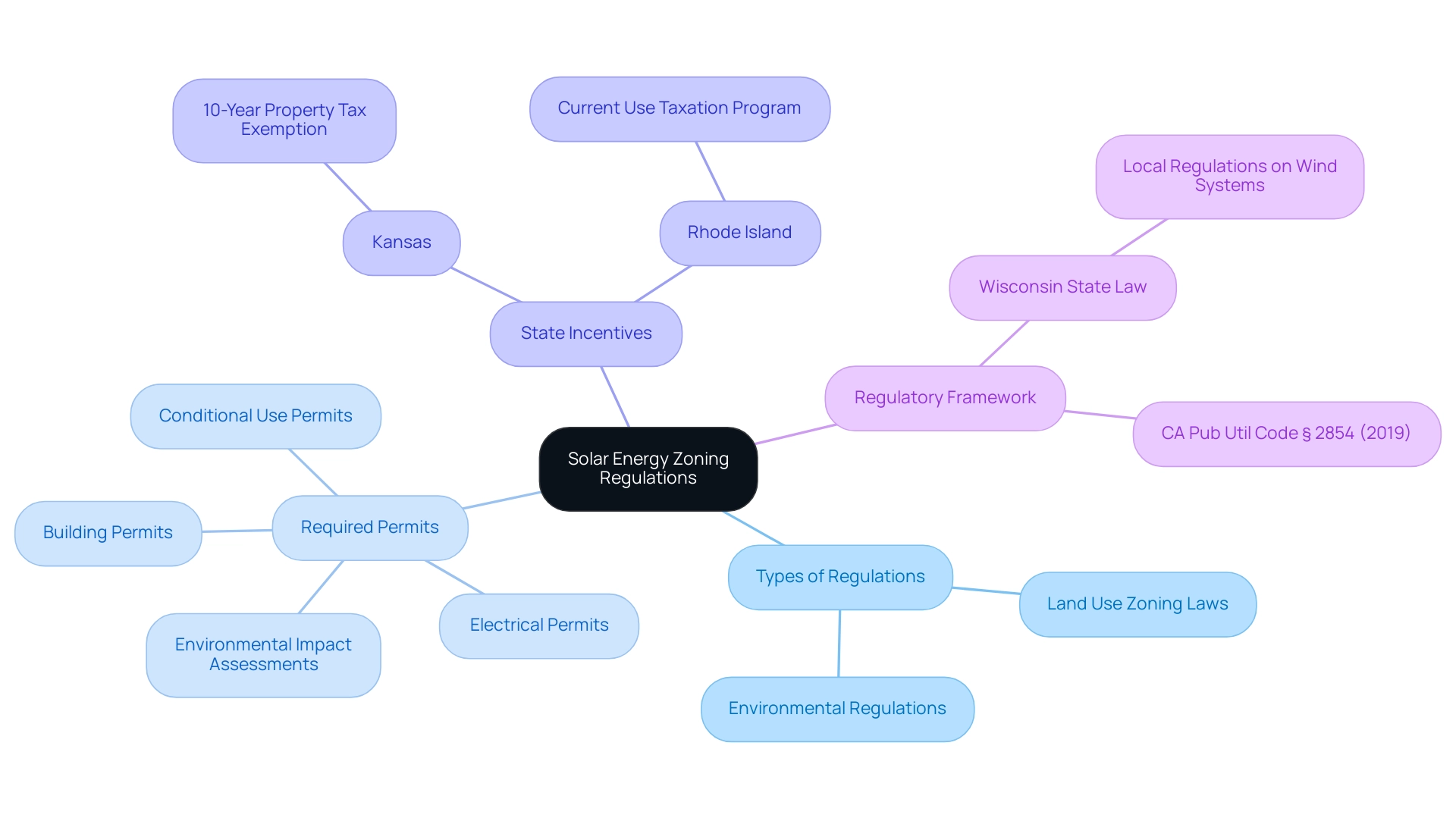
Step-by-Step Process for Achieving Solar Zoning Compliance
Achieving solar zoning compliance requires a structured approach involving several critical steps:
- Conduct a Site Assessment: Begin with a thorough evaluation of the site for solar installation. This includes evaluating land use compatibility and addressing any environmental factors that may affect the initiative.
- Research Local Regulations: Familiarize yourself with specific zoning laws and permitting requirements in your jurisdiction. Consulting local government resources or zoning boards is essential to understand the framework you must operate within.
- Prepare Necessary Documentation: Collect all requisite documentation, which typically includes site plans, environmental assessments, and engineering reports. This documentation must be comprehensive to facilitate the application process.
- Submit Permit Applications: Accurately complete and submit all necessary permit applications to local authorities. Attention to detail is crucial here; errors or incomplete forms can lead to significant delays.
- Attend Public Hearings: Prepare to present your proposal at public hearings if necessary. This forum provides a chance to tackle local issues and foster backing for your initiative, which is essential for success.
- Respond to Feedback: Be open to input from regulatory bodies and local members. Modifying your plans in response to valid concerns can enhance community relations and improve the chances of approval.
- Obtain Final Approvals: After securing all necessary permits, you can proceed with the installation of the photovoltaic system. Ensure compliance with all conditions outlined in the permits to avoid future complications.
Adhering to these steps will simplify the process of attaining solar energy zoning compliance, assisting in the successful implementation of your renewable energy initiative. Significantly, over 2,400 local jurisdictions have established historic preservation ordinances, highlighting the significance of grasping local regulations in the context of installations. As emphasized by the U.S. Department of Energy, "The district now ranks first in the county for teacher salaries," which reflects the beneficial influence that renewable energy initiatives can have when properly integrated.
Furthermore, the case study on Collective Energy Initiatives demonstrates how municipalities can implement shared energy solutions for greater access to renewable energy, encouraging public involvement. Furthermore, adopting solar-ready codes for new construction can facilitate future installations, ensuring buildings are designed to accommodate renewable energy systems effectively.
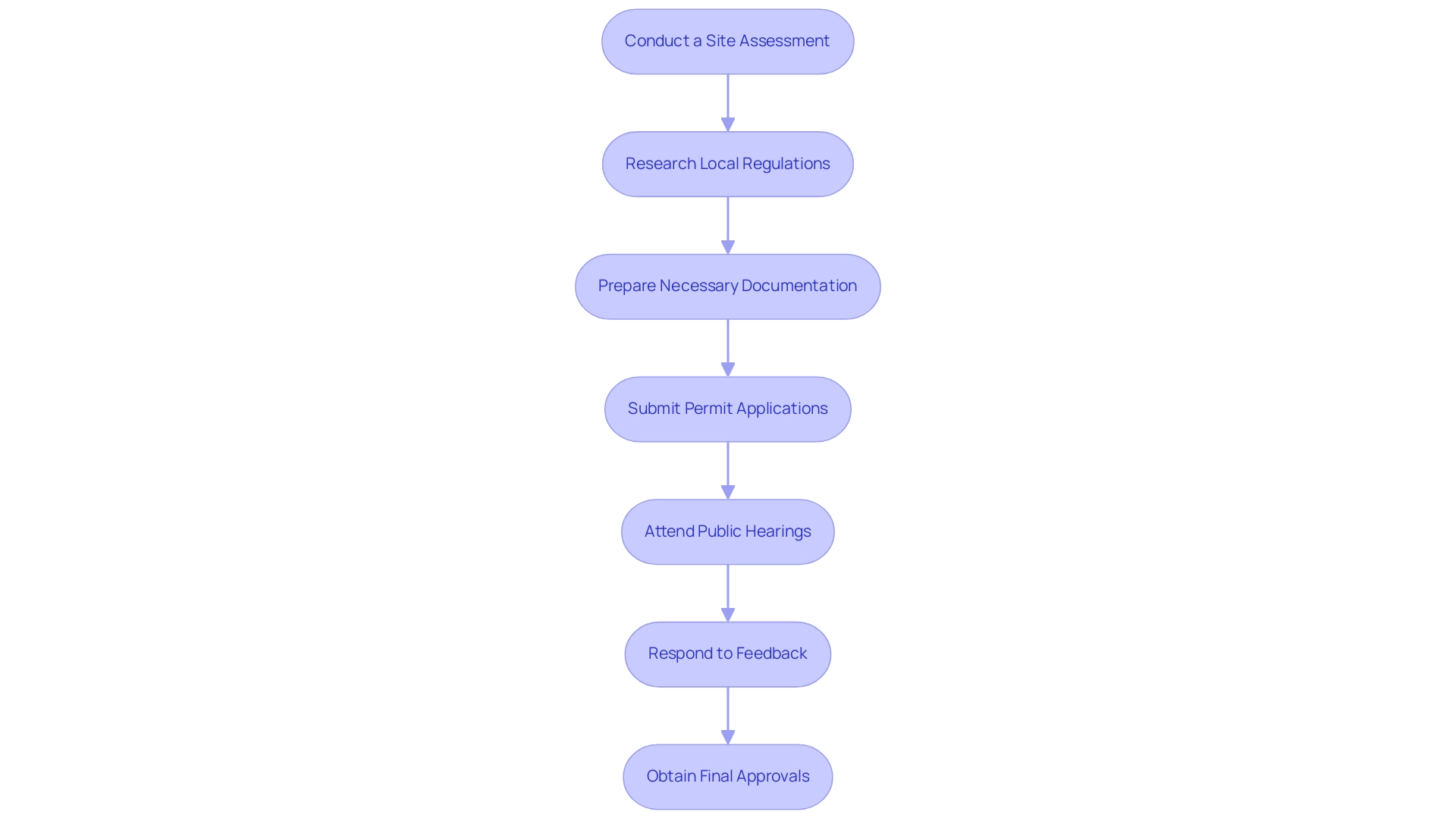
Engaging with Stakeholders and Community
Successfully interacting with stakeholders and the public is vital for the success of renewable energy initiatives. Here are several strategies to consider:
- Identify Key Stakeholders: Begin by pinpointing all stakeholders impacted by the energy initiative, including local residents, business owners, and government officials. Understanding their interests and concerns is essential for fostering collaboration.
- Organize Informational Meetings: Hosting informational meetings creates a platform for transparency. These sessions should tackle public concerns while outlining the initiative's benefits, such as job creation and the promotion of renewable energy. Notably, recent reports indicate that community energy initiatives are set to double by 2028, reaching an impressive 14 GW capacity, underscoring the growing importance of local engagement.
- Create Communication Channels: Establishing dedicated channels for ongoing communication—such as newsletters or specific websites—ensures stakeholders remain informed throughout the lifecycle. This continual dialogue is vital, especially as experts project that the renewable energy market will triple in size by 2028. As noted by industry experts, "Despite growing pains in this evolving industry, the solar market as a whole is set to triple in size by 2028," emphasizing the urgency of effective stakeholder engagement.
- Solicit Feedback: Actively encouraging members to share their opinions and concerns is fundamental. Utilize tools such as surveys or feedback forms to collect input that can significantly influence planning and execution. Some states even have mandates requiring a certain percentage of solar initiatives to be subscribed by low-income users or organizations, highlighting the importance of inclusive feedback.
- Adapt Plans Based on Input: Demonstrating responsiveness to public feedback fosters trust and respect. Be prepared to adjust plans based on stakeholder input, which not only enhances acceptance but also contributes to overall success. For example, Alliant Energy's recent renewable energy initiatives in Iowa successfully involved stakeholders, leading to a combined capacity of 200 MW, highlighting the beneficial results of effective local engagement.
Moreover, with industry leaders such as the SEIA advocating for the relaxation of permitting processes for renewable energy projects, it is essential to involve the public effectively to manage these regulatory challenges. By applying these public engagement strategies, you can foster a supportive atmosphere that simplifies the solar energy zoning compliance process, paving the way for successful renewable energy initiatives.
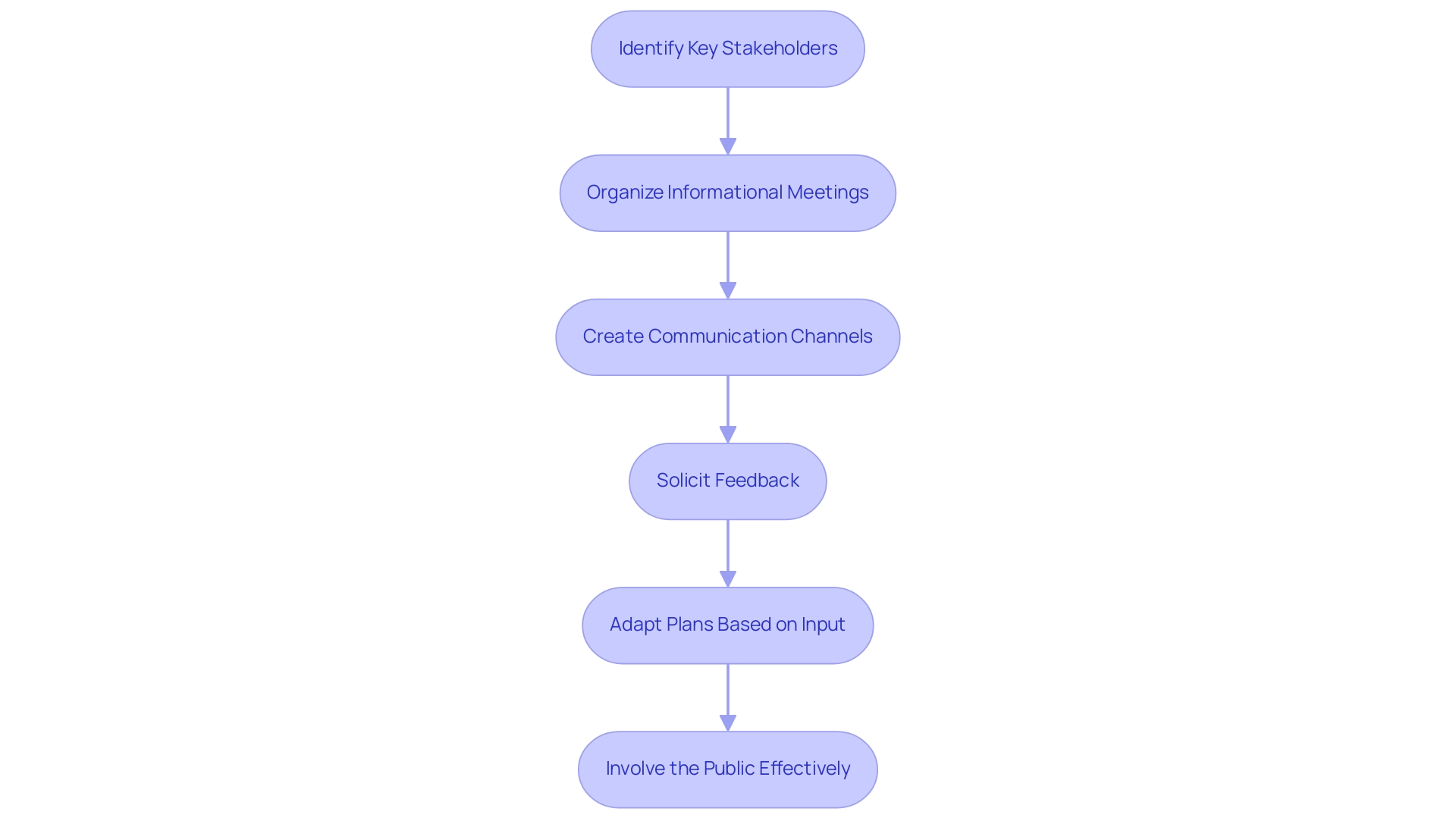
Navigating Common Challenges in Solar Zoning Compliance
In navigating solar zoning compliance, several common challenges may arise that require strategic planning and informed responses:
- Complex Regulatory Frameworks: Zoning laws can differ substantially across jurisdictions, creating a labyrinth for developers. Collaborating with local zoning experts or legal advisors is essential to grasp the specific requirements applicable to your area, ensuring that all legal nuances are understood and adhered to.
- Local Resistance: Growing opposition to solar initiatives arises from aesthetic issues and perceived environmental effects. With a reported 57% increase in contested renewable energy initiatives as of May 2023, it is crucial to engage in open dialogues with community members. Demonstrating the initiative's benefits, such as economic opportunities and environmental sustainability, can help alleviate concerns and foster local support.
- Delays in Permitting: The permitting process for solar initiatives can often extend beyond initial timelines, particularly for those triggering an Environmental Impact Statement (EIS), which may take seven times longer than standard approvals. To counteract this, ensure that applications are meticulously prepared and submitted well in advance, coupled with proactive communication with relevant permitting authorities to expedite the process. Additionally, it's important to note that from 2000 to 2018, the average completion rate for battery initiatives was only 11 percent, highlighting the broader context of timelines and challenges.
- Environmental Concerns: Projects frequently undergo rigorous scrutiny regarding their environmental footprint, including noise modeling and endangered resources reviews. Conducting comprehensive environmental assessments upfront will not only identify potential issues but also allow for adjustments in planning to mitigate adverse effects. This proactive approach can enhance the initiative's acceptance within the community.
- Funding and Financial Viability: Obtaining sufficient financing for renewable energy initiatives can be a considerable obstacle. Investigating various funding options, such as grants, loans, and tax incentives specifically allocated for renewable initiatives, can offer the essential financial backing to realize your endeavor.
As Wendy Edelberg, Director of The Hamilton Project, states, "The Hamilton Project has released several evidence-based policy proposals to help accelerate crucial climate reform in the United States," which underscores the importance of solar energy zoning compliance in addressing zoning regulations for renewable resources. By anticipating these challenges and developing thoughtful strategies to address them, you can significantly enhance the likelihood of successful compliance and implementation.
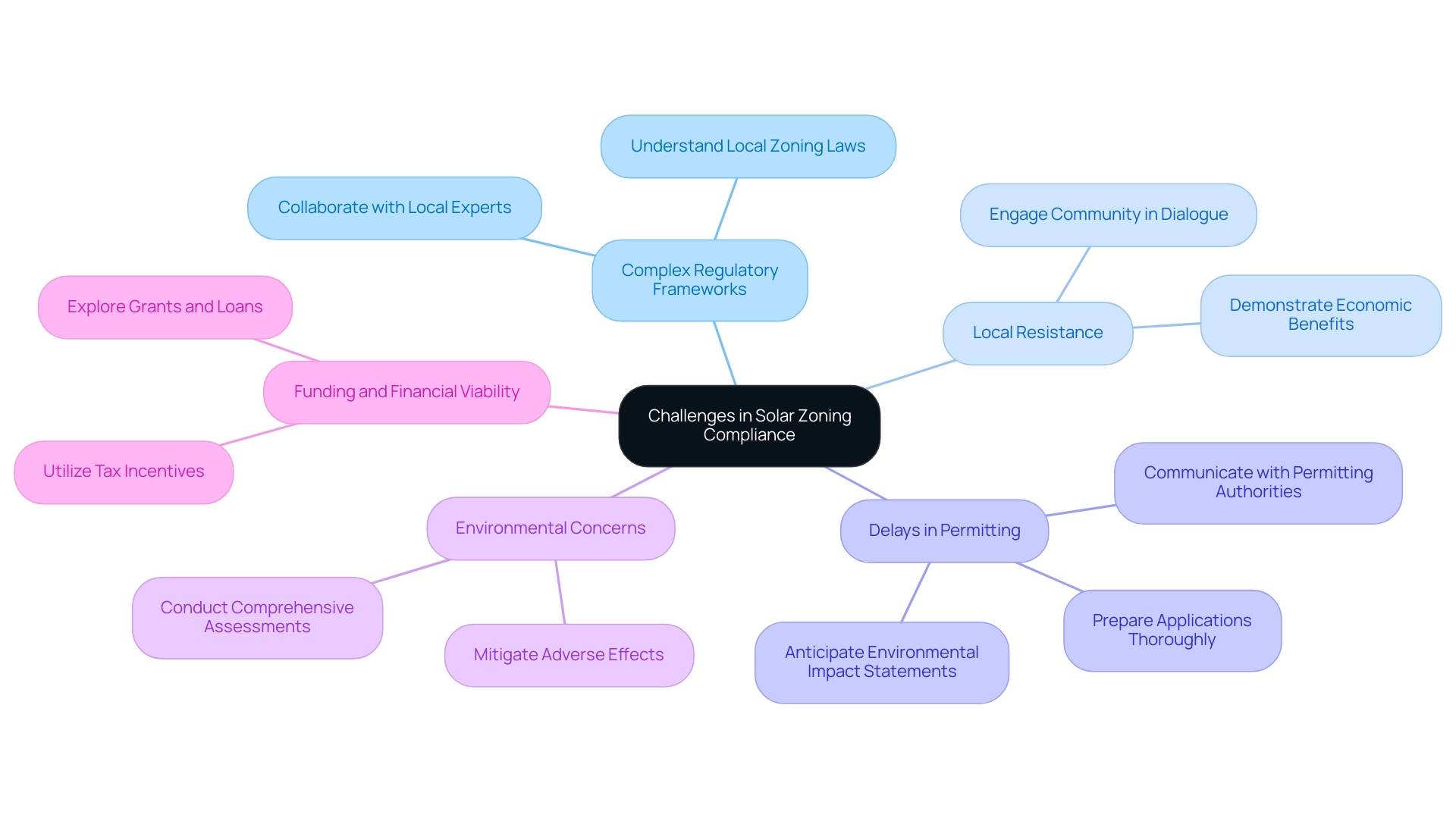
Post-Compliance: Maintaining Zoning and Permits
Maintaining solar energy zoning compliance while adhering to regulations and permits is crucial for the ongoing success of your energy initiative. Here are best practices to ensure continued compliance:
- Regularly Review Compliance Requirements: Stay informed about any changes in local regulations or zoning laws that could affect your undertaking. This vigilance helps mitigate risks associated with non-compliance.
- Conduct Routine Inspections: Schedule consistent inspections of the solar installation to verify continued compliance with safety and operational standards. Regular inspections are vital for achieving solar energy zoning compliance, as they not only ensure adherence to regulations but also enhance the overall efficiency of the system.
- Update Permits as Needed: If there are any modifications to the undertaking, it is essential to update all relevant permits to reflect these changes. This proactive approach helps avoid potential legal issues and ensures that your project remains compliant with solar energy zoning compliance throughout its lifecycle.
- Engage with the Public: Maintain open lines of communication with stakeholders and the public to foster goodwill and address any concerns that may arise. Engaging with the community can also help you stay informed about local sentiment and any emerging issues.
- Document Everything: Keep meticulous records of all compliance activities, inspections, and communications with regulatory bodies. This documentation is critical for demonstrating ongoing adherence to requirements and can be invaluable in the event of audits or inspections.
Implementing these best practices not only protects your energy initiative but also improves its sustainability and success over the long run. As noted by industry expert Barry Elad, “About 90% to 97% of renewable energy material is recyclable and can be reused for other purposes when it breaks down,” underscoring the importance of integrating sustainability into compliance practices. Furthermore, advancements in technology, as emphasized in the case study titled "Impact of Technology Improvements on Capacity Factors," indicate that enhancements such as bifaciality and inverter efficiency can further improve compliance and operational effectiveness in renewable energy initiatives.
Furthermore, staying updated with the quarterly U.S. solar market insight report can provide timely information on current trends affecting solar energy zoning compliance and regulations in the solar industry, ensuring that your project remains at the forefront of regulatory adherence.
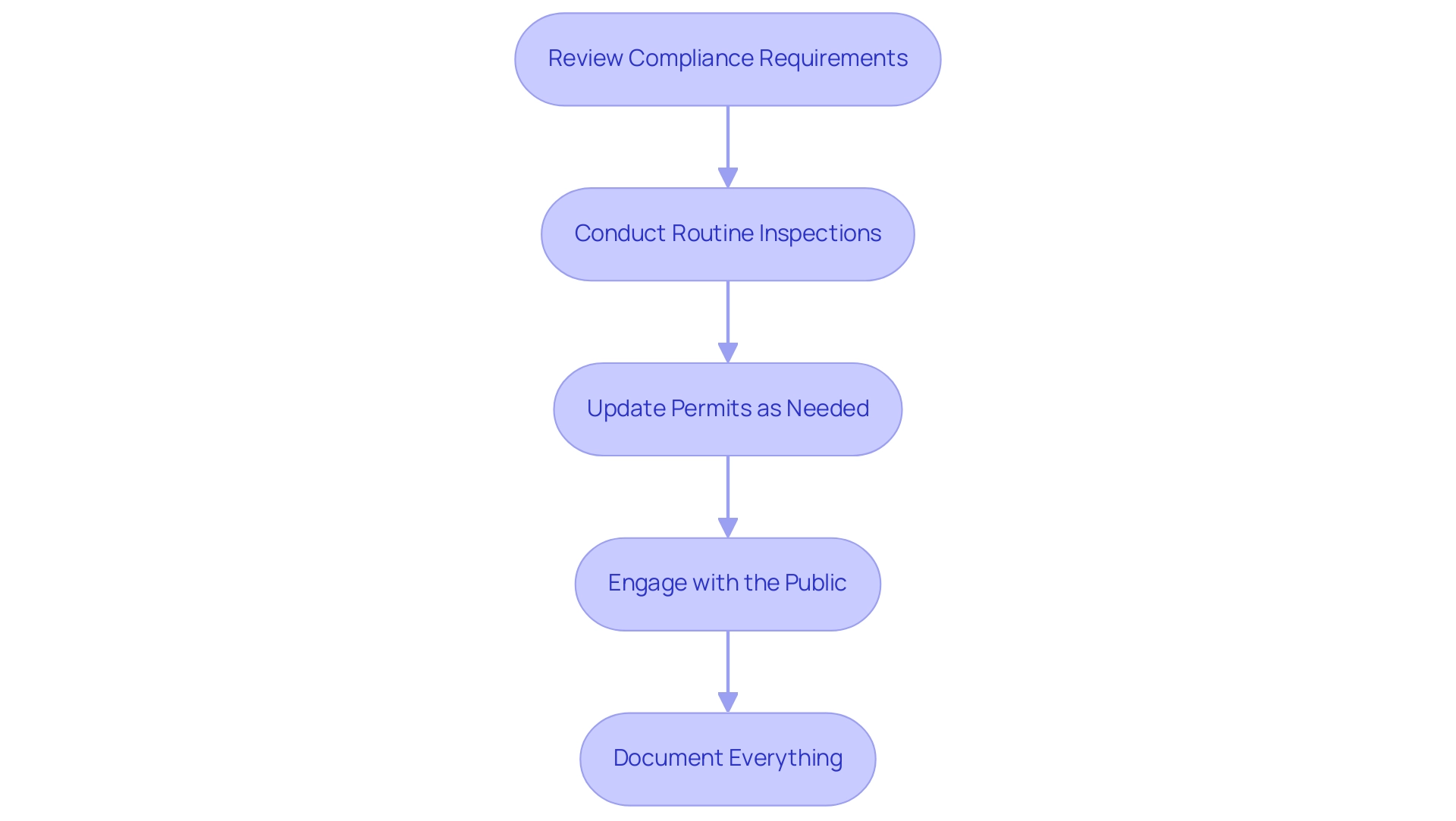
Conclusion
Navigating the complexities of solar energy zoning is essential for the successful implementation of renewable energy projects. This article has outlined the critical components of achieving and maintaining zoning compliance, emphasizing the importance of understanding local, state, and federal regulations. Key steps include:
- Securing necessary permits
- Conducting thorough site assessments
- Preparing comprehensive documentation to facilitate the approval process
Engaging effectively with stakeholders and the community is equally vital, as it fosters collaboration and builds support for solar initiatives.
Moreover, addressing common challenges such as:
- Regulatory complexities
- Community opposition
- Environmental concerns
can significantly influence the outcome of solar projects. By anticipating these hurdles and developing strategic responses, stakeholders can enhance the likelihood of successful compliance. Post-compliance, maintaining diligence through regular inspections, updating permits as needed, and keeping open lines of communication with the community are essential practices to ensure the long-term success and sustainability of solar energy installations.
In conclusion, proactive planning and community involvement are paramount in navigating the intricate landscape of solar energy zoning. By adhering to regulatory requirements and fostering positive relationships with stakeholders, the transition to renewable energy sources can be effectively achieved, paving the way for a sustainable future.
Frequently Asked Questions
What regulations must be understood for solar energy zoning compliance?
Navigating solar energy zoning compliance requires understanding local, state, and federal regulations, including land use zoning laws and environmental regulations that protect local ecosystems.
What are the common permits needed for solar energy projects?
Commonly required permits include: 1. Building Permits: For the installation of photovoltaic panels, ensuring safety standards are met. 2. Electrical Permits: For safely connecting photovoltaic systems to the electrical grid in accordance with electrical codes. 3. Conditional Use Permits: For developments that do not conform to existing zoning laws, allowing exceptions under specified conditions. 4. Environmental Impact Assessments: Required in certain regions to evaluate the ecological effects of the installation.
What financial incentives exist for solar energy projects in Kansas and Rhode Island?
In Kansas, properties producing renewable electricity receive a 10-year property tax exemption post-construction. In Rhode Island, farmland designated for renewable resources can avoid land use change taxes through a current use taxation program.
What is the significance of the CA Pub Util Code § 2854 (2019)?
This code mandates local publicly owned electric utilities to implement programs related to renewable resources, promoting the advancement of solar-related projects.
What steps should be taken to achieve solar zoning compliance?
The steps include: 1. Conducting a site assessment. 2. Researching local regulations. 3. Preparing necessary documentation. 4. Submitting permit applications. 5. Attending public hearings. 6. Responding to feedback. 7. Obtaining final approvals.
Why is it important to understand local regulations in solar energy projects?
Understanding local regulations is crucial as over 2,400 local jurisdictions have established historic preservation ordinances, and compliance with these regulations facilitates smoother approval processes for renewable energy initiatives.
How can municipalities encourage renewable energy access?
Municipalities can implement shared energy solutions and adopt solar-ready codes for new construction, ensuring buildings are designed to accommodate renewable energy systems effectively.
List of Sources
- Understanding Solar Energy Zoning: Key Regulations and Permits
- Farmland Solar Policy State Law Database (https://farmandenergyinitiative.org/projects/farmland-solar-policy/state-law-database)
- Wind, Solar and Siting: A Look at Recent Laws and Legislative Trends in the Midwest - CSG Midwest (https://csgmidwest.org/2024/02/29/wind-solar-and-siting)
- Step-by-Step Process for Achieving Solar Zoning Compliance
- solsmart.org (https://solsmart.org/resource/planning-zoning-development)
- Local Government Guide for Solar Deployment (https://energy.gov/eere/solar/local-government-guide-solar-deployment)
- farmandenergyinitiative.org (https://farmandenergyinitiative.org/projects/farmland-solar-policy/policy-design-toolkit/land-use-permitting-processes)
- Engaging with Stakeholders and Community
- Community Solar: A Growing Opportunity Within Commercial Real Estate (https://cbre.com/insights/viewpoints/community-solar-a-growing-opportunity-within-commercial-real-estate)
- Community Solar Market Trends (https://energy.gov/communitysolar/community-solar-market-trends)
- DOE invests in community engagement research for solar sites (https://pv-tech.org/doe-invests-in-community-engagement-research-for-solar-sites)
- arcadia.com (https://arcadia.com/blog/community-solar-statistics)
- Navigating Common Challenges in Solar Zoning Compliance
- brookings.edu (https://brookings.edu/articles/eight-facts-about-permitting-and-the-clean-energy-transition)
- Regulating Utility-Scale Solar Projects on Agricultural Land (https://kleinmanenergy.upenn.edu/research/publications/regulating-utility-scale-solar-projects-on-agricultural-land)
- Eight facts about permitting and the clean energy transition - The Hamilton Project (https://hamiltonproject.org/publication/economic-fact/eight-facts-permitting-clean-energy-transition)
- Solar Installations | | Wisconsin DNR (https://dnr.wisconsin.gov/topic/Sectors/SolarInstallations)
- Post-Compliance: Maintaining Zoning and Permits
- Solar Energy Statistics and Facts 2024 (https://electroiq.com/stats/solar-energy-statistics)
- Solar Market Insight Report 2021 Year in Review (https://seia.org/research-resources/solar-market-insight-report-2021-year-review)
- ember-energy.org (https://ember-energy.org/latest-insights/solar-power-continues-to-surge-in-2024)
- atb.nrel.gov (https://atb.nrel.gov/electricity/2023/utility-scale_pv)




